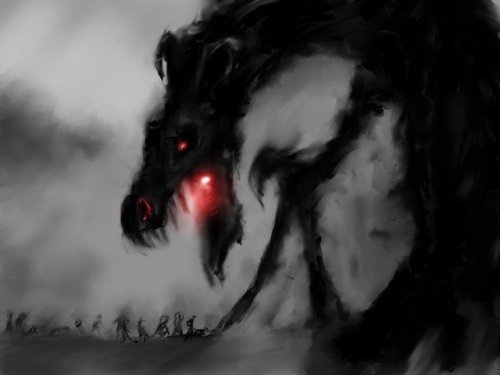Developed by Fridgar
Price: Tier 9 minimum for a corpse.
Habitat: Underground and in dark caves, they build their nests around Roipo pots. (Scalvoris Mainland)
Lifespan and Development: Scalv Ziemia hatch in groups of four to five in the nectar of Roipo pots. They're often 5-6 feet long as hatchlings and weigh roughly 90-120 lbs. Upon emerging from the eggshell, their scales are soft and very delicate, they break like paper, their scales are often white without any patterns at the age of 0. Thanks to the prolonged effects of constant absorption of Roipo Nectar over dozens of generations of Scalv Ziemia, they mature very quickly over the space of 30 trials.
At 10 trials old, the Scalv Ziemia has grown to 20-25 feet long, they weigh in at about 300-400lbs. Their scales have hardened up enough and can take a little more punishment than the skin on people and animals, their scales usually change pigment at this age to a grey or brown, depending on the stone native to the Scalv Ziemia's place of birth. Their fangs develop at this point too; large, dagger sized points of super hard bone, some claim it to be harder than steel. This makes the young Scalv Ziemia very susceptible to poachers as their fangs sell for a pretty nel. They often leave the nest at this age, ready to take on most prey and predators alike. They hunt with stealth, striking at the very last second and crushing their prey in their coils at 90-95psi and swallowing them whole, often still alive.
Come the age of 20 trials, the Scalv Ziemia Is barely recognisable, stretching as far as 46-52 feet long and weighing in at roughly 820-950 lbs, they gain considerable thickness in their tails which add greatly to their previously mentioned crushing power. Their scales are harder than the stone itself at this age, they shrug off most attacks by humans and other animals alike, they are immune to bladed weapons including axes. Bludgeons do little unless the wielder is also an expert in strength. Their bones are harder than steel at this point and tear through plate armour like cardboard. The creature is very dangerous at this age. Their scales are now completely to their transition of either brown or grey and along their backs, dark patterns have formed in brilliant tapestry, stretching across their body, sometimes touching the under belly of the beast. The marks are often black but have been seen in deep shades of red, blue and green. Scalv Ziemia are notorious for feeding on farmer's livestock, their accelerated growth requires a lot of sustenance, five times its weight in meat.
Finally, at adulthood, the Scalv Ziemia has fully grown at the age of 30 trials. Their long bodies stretch from 60-74 feet long and weigh in between 1000 and 1450 lbs. Though the largest Scalv Ziemia ever recorded measured at a staggering 80 feet long and weighed 1560lbs. These creatures are monstrous in appearance, wielding fangs like short swords, stronger than most conventional metals. Their scales don't develop much at this age, having already achieved near enough to their peak of toughness at 20 trials old, except for spines that grow in pairs along their back, in the colour of their markings. Melee doesn't affect the Scalv Ziemia unless the wielder is at master strength or above, and even then, the Scalv Ziemia is ridiculously hard to break through, it is recommended that you wield a pickaxe should you be foolish enough to fight this thing with a melee weapon at all. Mages, alchemists and other sorts of "heavy duty damage" are often needed to dispose of these creatures. They have all but abandoned the crushing method for their prey and often swallow small and medium animals, sometimes large ones, whole without difficulty. it's rare that these behemoths emerge from their caves or underground nests however.
Scalv Ziemia live for up to 10 arcs and can settle down to start their own nests at any age after 30 trials, when their massive metabolisms slow down to half their body weight in food a week.
Diet: Carnivorous, during their younger days the Scalv Ziemia needs constant access to massive volumes of meat. Most Scalv Ziemia perish due to lack of sustenance to their enormous appetites and accelerated metabolisms.
Temperament: Aggressive before adulthood and will often go out of their way to kill and eat anything in its vicinity. Though calm significantly at the age of 28 trials. Scalv Ziemia often live their lives underground. There are legends of them being hardy workers for those brave souls that tame them at the age of 30 trials although that might be nothing more than an urban legend. If the owner of the beast can provide massive amounts of food for the creature, they don't see much harm in lending a hand to the weaker animals. Should a master forget to feed their new companion, they best hope that their beloved pet doesn't turn on them for their next meal.
Abilities: Massive strength, weight, super thick scales harder than stone.
Weaknesses: Scalv Ziemia cannot function in the cold, often lock up unable to operate due to their cold-blooded reptilian nature. That and they always need massive amounts of food, starvation and extinction is a huge peril for these creatures if they can't find a way to control their growing numbers. Their fangs too, while not venomous, they can pierce their ridiculously hard skin much easier than most other metals and weapons. Alongside this, the Scalv Ziemia can only function in almost complete darkness, as arcs of living underground has left them incredibly sensitive to light.
| ! | Message from: Peg |
| There are secrets to be discovered about this creature! |








